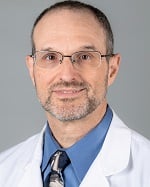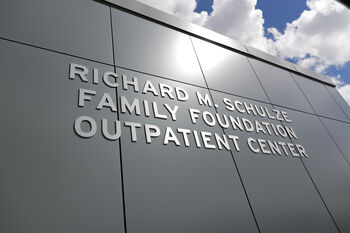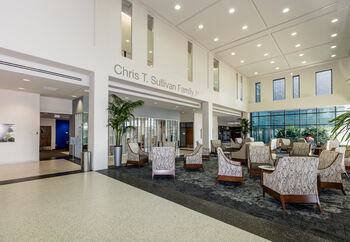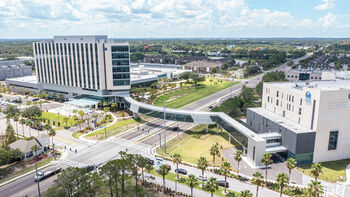Moffitt’s McKinley Outpatient Center Celebrates 10th Anniversary
Watching the flow of patients in and out of the Richard M. Shulze Family Foundation Outpatient Center is like witnessing a well-oiled machine. And after 10 years, it should come as no surprise that the estimated 1,000 patients that are seen here each day have convenient access to care for many different types of cancer.
In November 2015, Moffitt Cancer Center celebrated its first major expansion project with the opening of the outpatient center, also called the McKinley Campus. The new center on McKinley Drive in Tampa was built with quality of care top of mind. Equally as important during the planning phase, however, was enhancing the patient experience.
“When you walk into this campus you feel like you’re in a high-end hotel rather than a clinic space,” said Darcelle Welker, director of Nursing at the McKinley campus. “It feels calming and relaxing and everything from the colors to the furniture to the wayfinding all contribute to that.”
-
1.6 million
Patients have been treated here since 2015
-
About 1,000
Patients are treated here each day
-
266,000
Patients have had blood work done here
-
84,000
Patients received infusion here
Designed for “Patients First”

The McKinley Campus was designed with warmer and more comfortable details to create a more welcoming atmosphere for patients.
In keeping with the “patients first” mentality of Moffitt, members of the cancer center’s Patient and Family Advisory Council helped design the building. Those insights helped create an atmosphere of comfort rather than stress and provided conveniences that may have otherwise been overlooked.
According to Carla Magazine, manager of Patient Experience Services, the McKinley Campus was an opportunity to involve patients’ perspectives from the very early stages of planning.
“From its inception, we knew we had the rare opportunity to design a healing environment built entirely around the needs and experiences of our patients and families,” Magazine said. “We partnered early on with our incredible patient advisors whose voices shaped everything from interior design and color palette to the overall flow and feel of the patient journey.”
That design created a convenient and easy-to-navigate building that also fueled productivity and collaboration. Having multidisciplinary clinics all under one roof benefits both patients and the clinic teams.

“Whether it’s the initial consultation or subsequent cancer surgery or intravenous drug treatments, our patients can see the specialists they need to see, get the x-rays or scans they need to direct their treatment and the operations and medications they need are all in one building,” said Vernon Sondak, MD, chair of Moffitt’s Cutaneous Oncology Department. “For us as providers, it’s a home base where our offices are literally steps away from our patients and from each other.”
That proximity makes collaboration more efficient and more beneficial to the patients treated at Moffitt.
Blaise Mooney, MD, breast radiologist and medical director of the outpatient center, says the McKinley campus allows patients to access a level of personalized care that can be difficult to achieve in larger complexes. In its first decade, the McKinley campus added a Critical Research Unit and expanded its infusion services, all with patient care front of mind.
“The growth and level of complexity of patients treated on the campus has been incredible,” Mooney said. “The growth has turned McKinley into a mini hospital and smaller facilities like this make rapid and convenient access to the highest level of cancer care possible.”
If a patient needs surgery, Moffitt clinicians can get them into one of the building’s five operating rooms quickly, Mooney says. If patients need more acute care, it can be expedited thanks to the way in which the building was designed.
What’s in a Name?
Three years after the campus opened its doors, a new sign was unveiled on the side of the new building declaring it the Richard M. Shulze Family Foundation Outpatient Center. The 2018 change came in recognition of a financial gift that was used in part to ensure patients had access to a cutaneous oncology program with the technology and means to make the treatment of skin cancers more effective. The confocal microscopy unit the cutaneous oncology team regularly uses at McKinley is a direct result of that gift.

The building was renamed the Richard M. Schulze Family Outpatient Center in 2018.
This device helps make surgical and nonsurgical treatments of melanoma and other skin cancers more effective by helping define edges of the cancer that are difficult to determine visually. Other uses of the financial gift have been for funding younger members of the faculty to enhance their ability to consult research and compete for grants from both state and federal agencies.
“The generosity of the Schulze Family Foundation has helped support research and Moffitt’s ability to collaborate and publish its work around the world,” Sondak said. “We’re indebted to Richard Schulze and his entire family for their support.”
When Cancer Gets Personal
Advances in cancer care would not be possible without a collaborative team. And for Mooney, the support the team members at McKinley give each other is inspiring. He said members of each department work collaboratively to deliver effective and efficient care across the entire cancer spectrum.
“We all know what is at stake,” Mooney said, who is a head and neck cancer survivor and most recently, a caregiver. His wife was diagnosed with breast cancer following an ultrasound performed in the breast radiology unit at McKinley. As a doctor, Mooney knew the risks and challenges that come with a breast cancer diagnosis. Fortunately, his colleagues offered him some invaluable advice.

“They told me to stop being a doctor and to be a husband and supportive spouse,” Mooney said. “I needed to be a listener and let the people I know, trust and work with every day take care of her.”
Mooney followed that advice and took a step back. After months of blood draws, surgery and follow-up appointments, Mooney can breathe a sigh of relief.
“Everything is perfect,” Mooney said. “Her care was flawless and the staff were beyond professional and friendly.”
An Ongoing Evolution
A lot has happened on the Moffitt McKinley campus since it opened its doors. More clinics have moved in and recently the building extended its hours into the weekends. The space was built in a way that helps the staff adapt to growth and change.
“From the very beginning, we anticipated the need for growth and flexibility and built agility into the foundation of the center’s design,” Magazine said. “Each care area was thoughtfully placed to allow for future reimagining. Diagnostic imaging, for instance, was positioned on the first floor near the garden to allow for possible expansion.”

The Chris T. Sullivan Family Lobby offers an open space for patients and families.
The design even helped with the unexpected and unpredictable atmosphere of 2020, Darcelle Welker says.
“We had some shifts during the COVID-19 pandemic,” Welker said. “Our infusion team popped up a curbside clinic that was an innovation no one ever could have predicted, but we made it work.”
The outdoor clinic allowed patients access to cancer care while maintaining social distancing to combat any airborne illnesses. It’s just one example of how McKinley has adapted to change and growth over the last decade, Welker says.
“I remember on that first day just how massive this building felt,” Welker said. “We thought we would never fill the space. Here we are 10 years later and we’re at capacity and we’ve been able to adapt and adjust to handle the volume of patients we need to see because the campus was built and planned for growth.”
What’s Next?
Since 2015, Moffitt has expanded its services outside of the immediate Tampa Bay area. In 2024 Moffitt at Southshore opened its clinic space in Ruskin, and in 2026 Moffitt will welcome patients to a clinic space at Pasco County’s Moffitt Cancer Center at Speros campus.

In 2023 the Moffitt McKinley Hospital opened and now connects directly to the McKinley Outpatient Center with a footbridge across McKinley Drive.
But that doesn’t mean growth has stopped at McKinley. In 2022 the Moffitt McKinley Hospital opened across the street from the outpatient center. By the summer of 2028, a 200-room hotel will open to offer patients, families and visiting physicians a convenient and comfortable place to stay.
After 10 years, the McKinley facility has seen a lot of change and those who work there are ready for the next decade and whatever it may bring.
“McKinley continues to evolve because of the extraordinary people who bring its purpose to life each day,” Magazine said.




